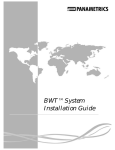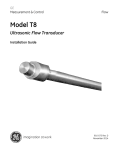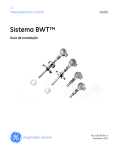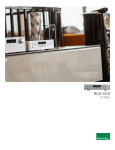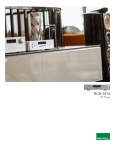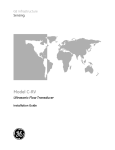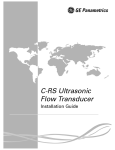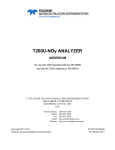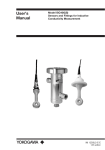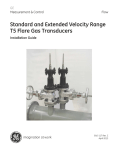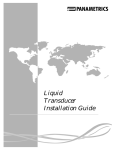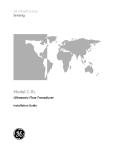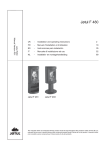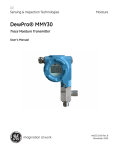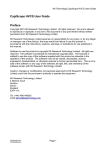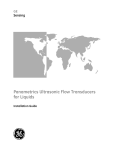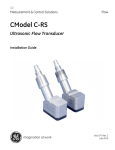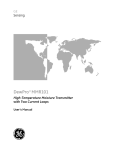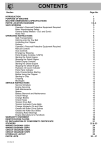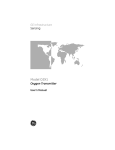Download BWTTM System Installation Guide
Transcript
BWTTM System Installation Guide April 2004 Process Control Instruments BWTTM System Installation Guide 916-058B April 2004 Table of Contents Chapter 1: General Information Introduction . . . . . . . . . . . . . . . . . . . . . . . . . . . . . . . . . . . . . . . . . . . . . . . . . . . . . . . . . . . . . . . . . .1-1 Types of BWT Buffers. . . . . . . . . . . . . . . . . . . . . . . . . . . . . . . . . . . . . . . . . . . . . . . . . . . . . . . . . .1-1 General Guidelines for Transducer Position and Location . . . . . . . . . . . . . . . . . . . . . . . . . . . . . .1-2 BWT Meter Body . . . . . . . . . . . . . . . . . . . . . . . . . . . . . . . . . . . . . . . . . . . . . . . . . . . . . . . . . . . . .1-3 Single-Traverse Meter Body. . . . . . . . . . . . . . . . . . . . . . . . . . . . . . . . . . . . . . . . . . . . . . . . . .1-3 Double-Traverse Meter Body . . . . . . . . . . . . . . . . . . . . . . . . . . . . . . . . . . . . . . . . . . . . . . . . .1-4 Handling and Installing a Meter Body . . . . . . . . . . . . . . . . . . . . . . . . . . . . . . . . . . . . . . . . . . . . .1-5 Unpacking a Meter Body . . . . . . . . . . . . . . . . . . . . . . . . . . . . . . . . . . . . . . . . . . . . . . . . . . . .1-5 Installing a Meter Body. . . . . . . . . . . . . . . . . . . . . . . . . . . . . . . . . . . . . . . . . . . . . . . . . . . . . .1-5 Welding Requirements. . . . . . . . . . . . . . . . . . . . . . . . . . . . . . . . . . . . . . . . . . . . . . . . . . . . . . . . . .1-6 Meter Body Requirements When Flushing . . . . . . . . . . . . . . . . . . . . . . . . . . . . . . . . . . . . . . . . . .1-7 Chapter 2: Installing Standard FTPA BWT Buffers and Transducers Introduction . . . . . . . . . . . . . . . . . . . . . . . . . . . . . . . . . . . . . . . . . . . . . . . . . . . . . . . . . . . . . . . . . .2-1 Identifying and Checking Components . . . . . . . . . . . . . . . . . . . . . . . . . . . . . . . . . . . . . . . . . . . . .2-1 Assembling the Standard FTPA Buffer . . . . . . . . . . . . . . . . . . . . . . . . . . . . . . . . . . . . . . . . . . . . .2-3 Inserting the Standard FTPA Buffer . . . . . . . . . . . . . . . . . . . . . . . . . . . . . . . . . . . . . . . . . . . . . . .2-4 Torquing the Studs. . . . . . . . . . . . . . . . . . . . . . . . . . . . . . . . . . . . . . . . . . . . . . . . . . . . . . . . . . . . .2-6 Installing the BWT Transducer . . . . . . . . . . . . . . . . . . . . . . . . . . . . . . . . . . . . . . . . . . . . . . . . . . .2-9 Installing and Orienting the Junction Box . . . . . . . . . . . . . . . . . . . . . . . . . . . . . . . . . . . . . . .2-9 Inserting the BWT Transducer . . . . . . . . . . . . . . . . . . . . . . . . . . . . . . . . . . . . . . . . . . . . . . .2-10 Verifying Installation . . . . . . . . . . . . . . . . . . . . . . . . . . . . . . . . . . . . . . . . . . . . . . . . . . . . . .2-11 Chapter 3: Installing Acoustic Isolation FIPA BWT Buffers and Transducers Introduction . . . . . . . . . . . . . . . . . . . . . . . . . . . . . . . . . . . . . . . . . . . . . . . . . . . . . . . . . . . . . . . . . .3-1 Identifying and Checking Components . . . . . . . . . . . . . . . . . . . . . . . . . . . . . . . . . . . . . . . . . . . . .3-1 Inserting the Acoustic Isolation FIPA Buffer . . . . . . . . . . . . . . . . . . . . . . . . . . . . . . . . . . . . . . . .3-3 Torquing the Studs. . . . . . . . . . . . . . . . . . . . . . . . . . . . . . . . . . . . . . . . . . . . . . . . . . . . . . . . . . . . .3-7 Installing the BWT Transducer . . . . . . . . . . . . . . . . . . . . . . . . . . . . . . . . . . . . . . . . . . . . . . . . . . 3-11 Installing the Orienting the Junction Box . . . . . . . . . . . . . . . . . . . . . . . . . . . . . . . . . . . . . . .3-11 Inserting the BWT Transducer . . . . . . . . . . . . . . . . . . . . . . . . . . . . . . . . . . . . . . . . . . . . . . .3-12 Verifying Installation . . . . . . . . . . . . . . . . . . . . . . . . . . . . . . . . . . . . . . . . . . . . . . . . . . . . . .3-14 Installing Additional Acoustic Isolation . . . . . . . . . . . . . . . . . . . . . . . . . . . . . . . . . . . . . . . . . . .3-15 Chapter 4: Installing Non-Flanged FSPA/FWPA BWT Buffers and Transducers Installing Non-Flanged FSPA/FWPA BWT Buffers and Transducers . . . . . . . . . . . . . . . . . . . . .4-1 Installing the FSPA/FWPA Buffer . . . . . . . . . . . . . . . . . . . . . . . . . . . . . . . . . . . . . . . . . . . . .4-2 Installing and Orienting the Junction Box . . . . . . . . . . . . . . . . . . . . . . . . . . . . . . . . . . . . . . .4-3 Inserting the BWT Transducers . . . . . . . . . . . . . . . . . . . . . . . . . . . . . . . . . . . . . . . . . . . . . . .4-4 Verifying Installation . . . . . . . . . . . . . . . . . . . . . . . . . . . . . . . . . . . . . . . . . . . . . . . . . . . . . . .4-5 Chapter 5: Specifications Specifications. . . . . . . . . . . . . . . . . . . . . . . . . . . . . . . . . . . . . . . . . . . . . . . . . . . . . . . . . . . . . . . . .5-1 iii April 2004 Warranty Each instrument manufactured by GE Panametrics is warranted to be free from defects in material and workmanship. Liability under this warranty is limited to restoring the instrument to normal operation or replacing the instrument, at the sole discretion of GE Panametrics. Fuses and batteries are specifically excluded from any liability. This warranty is effective from the date of delivery to the original purchaser. If GE Panametrics determines that the equipment was defective, the warranty period is: • one year for general electronic failures of the instrument • one year for mechanical failures of the sensor If GE Panametrics determines that the equipment was damaged by misuse, improper installation, the use of unauthorized replacement parts, or operating conditions outside the guidelines specified by GE Panametrics, the repairs are not covered under this warranty. The warranties set forth herein are exclusive and are in lieu of all other warranties whether statutory, express or implied (including warranties or merchantability and fitness for a particular purpose, and warranties arising from course of dealing or usage or trade). Return Policy If a GE Panametrics instrument malfunctions within the warranty period, the following procedure must be completed: 1. Notify GE Panametrics, giving full details of the problem, and provide the model number and serial number of the instrument. If the nature of the problem indicates the need for factory service, GE Panametrics will issue a RETURN AUTHORIZATION NUMBER (RAN), and shipping instructions for the return of the instrument to a service center will be provided. 2. If GE Panametrics instructs you to send your instrument to a service center, it must be shipped prepaid to the authorized repair station indicated in the shipping instructions. 3. Upon receipt, GE Panametrics will evaluate the instrument to determine the cause of the malfunction. Then, one of the following courses of action will then be taken: iv • If the damage is covered under the terms of the warranty, the instrument will be repaired at no cost to the owner and returned. • If GE Panametrics determines that the damage is not covered under the terms of the warranty, or if the warranty has expired, an estimate for the cost of the repairs at standard rates will be provided. Upon receipt of the owner’s approval to proceed, the instrument will be repaired and returned. Chapter 1 General Information Introduction . . . . . . . . . . . . . . . . . . . . . . . . . . . . . . . . . . . . . . . . . . . 1-1 Types of BWT Buffers . . . . . . . . . . . . . . . . . . . . . . . . . . . . . . . . . . . 1-1 General Guidelines for Transducer Position and Location . . . . . 1-2 BWT Meter Body. . . . . . . . . . . . . . . . . . . . . . . . . . . . . . . . . . . . . . . . 1-3 Handling and Installing a Meter Body . . . . . . . . . . . . . . . . . . . . . . 1-5 Welding Requirements. . . . . . . . . . . . . . . . . . . . . . . . . . . . . . . . . . . 1-6 Meter Body Requirements When Flushing . . . . . . . . . . . . . . . . . .1-7 April 2004 Introduction Installing the BWTTM System consists of creating a meter body, installing the transducer buffer, and then mounting transducers into the buffer. GE Panametrics offers a variety of buffers and meter bodies for liquid and gas applications. This section consists of general information for the following: • Types of BWT Buffers • General Guidelines for Transducer Position and Location • BWT Meter Body • Handling and Installing a Meter Body • Welding Requirements • Meter Body Requirements When Flushing Refer to the appropriate section of this manual to install the BWT buffers and transducers that you ordered. Types of BWT Buffers Buffers are used to protect the BWT transducers from temperature extremes. Since they mount directly into the pipe coupling or nozzle, they also act as barriers against the process, making it possible for the transducers to be removed without interrupting the process or emptying the pipe. There are three BWT buffer types available for transducers for liquid and gas applications: • Standard BWT Buffer (part number FTPA) - is used for liquid and gas applications. The buffer has a flanged process connection and is available in two lengths: 2 in. (temperatures up to 600oF/315oC) and 6 in. (temperatures up to 1,100oF/600oC). • Acoustic Isolation BWT Buffer (part number FIPA) - is used for gas applications at lower pressures. The buffer has a flanged isolation section that reduces acoustic short circuit. The outer buffer has a flanged process connection and is available in two lengths: 2 in. (temperatures up to 600oF/315oC) and 6 in. (temperatures up to 1,100oF/600oC). General Information 1-1 April 2004 Types of BWT Buffers (cont.) General Guidelines for Transducer Position and Location • Non-Flanged BWT Buffer (part number FSPA) - is used in liquid applications and has a 1 in. NPT thread. • Socket-Weld BWT Buffer (part number FWPA) - is used in liquid applications and has a 1 in. coupling that is welded into the pipe coupling. Whichever transducer type is selected for your installation, flowmeter accuracy depends on proper transducer location, spacing, alignment, and electronics programming. However, even though every transducer installation has specific location considerations, the following location guidelines apply to all transducers, regardless of type: Caution! A flowmeter’s accuracy and performance depends on the location, spacing, and alignment of the transducers. The specific spacing of your transducers are unique to your installation. 1. To help assure a uniform flow profile, locate the buffers so that there are at least 10 pipe diameters of straight, undisturbed flow upstream and 5 pipe diameters of straight, undisturbed flow downstream from the point of measurement. The more straight run available the better. “Undisturbed flow” means avoiding sources of turbulence such as valves, flanges, and elbows. You should also avoid swirl, cross flow and cavitation (in liquids). 2. It is important to locate the transducers on a horizontal plane. This specifically applies to mounting transducers on a horizontal pipe. One transducer cannot be on top of the pipe and one on the bottom, because the top of the pipe tends to accumulate gas (in liquids) and the bottom tends to accumulate sediment (in gas and liquids). These contaminants can attenuate or block the ultrasonic signal. There is no similar restriction with vertical pipes. However, in liquid applications you should avoid vertical downward flow to ensure a full pipe. 1-2 General Information April 2004 BWT Meter Body BWT installations typically use a tilted-diameter meter body. A tilteddiameter meter body is so named because the transducers send their pulses at an angle across the diameter of the pipe. This type of meter body can be configured as a single-traverse or double-traverse installation. Note: The mounting angle for the transducer is typically 45°, but other angles (20°, 30°, or 60°) can be used as required. Tilted diameter can also refer to paths that are off-diameter such as the mid-radius path. A meter body is created by mounting the nozzles on the existing pipeline, or on a meter body. A meter body is a precisionmanufactured section of matching pipe that contains the ports where the transducer buffers will be mounted. This setup allows more accurate transducer alignment before mounting the meter body into the pipeline. If requested, a meter body can be calibrated prior to shipment. All meter bodies are factory-supplied. Single-Traverse Meter Body A single-traverse configuration consists of two transducers mounted on opposite sides of the pipe so that the signal they transmit passes through the fluid just once, at a typical 45° angle (Figure 1-1 below). A single-traverse configuration may include more than one path (Figure 1-2 on the next page). Top View End View Figure 1-1: Single-Traverse, 2-Path, Diagonal 45 Meter Body General Information 1-3 April 2004 Single-Traverse Meter Body (cont.) Top Figure 1-2: Single-Traverse, 2-Path, Mid-Radius Meter Body Double-Traverse Meter Body A double-traverse configuration consists of two transducers mounted on the pipe so that the signal traverses the fluid two times before reaching the other transducer. See Figure 1-3 below. P = Distance that the signal travels through the liquid from one transducer to the other. P TOP o o 45 45 L L = Projected distance of acoustical path in liquid. Figure 1-3: Double-Traverse Meter Body 1-4 General Information April 2004 Handling and Installing a Meter Body To ensure proper nozzle alignment, GE Panametrics uses the highest quality welding and machining techniques when manufacturing meter bodies. Since proper alignment of the nozzles is important to making accurate flow measurement, great care must be taken when unpacking and installing the meter body. Unpacking a Meter Body Upon receipt, you should take great care in unpacking the meter body. Although meter bodies are constructed of steel, improper unpacking or handling can result in damage or affect nozzle alignment. Use the guidelines below for unpacking the meter body: Installing a Meter Body • Since the nozzles protrude from the pipe, take care when removing packing material and the meter body from its shipping container, so as not to disturb the nozzles. • After the meter body is removed from its shipping container, never allow the full weight of the meter body to rest on the nozzle or buffer. You should prop up the meter body to prevent it from rolling over, which again, may cause damage or misalignment of nozzles. • Do not let the meter body hit against other objects or surfaces. Nozzle alignment can be affected if the meter body is dropped onto sand or the ground. • If the meter body is shipped with the buffers already installed in the nozzles, take care as to not disturb the buffers when unpacking. Meter bodies can be either flanged or welded into the existing pipeline. Use the following steps to position the meter body into the pipeline (refer to Figure 1-4 on the next page): !WARNING! Before installing the meter body make sure pipe flushing is completed. For additional information when flushing is necessary, refer to Meter Body Requirements When Flushing on page 1-7. 1. Find the tag plate with the words TOP and FLOW DIRECTION marked on it. If the meter body is flanged, two bolt holes should straddle the vertical centerline. IMPORTANT: In general (including cases where the meter body axis is not horizontal), be sure that the installation does not allow gas or sediment to deposit in the transducer ports. Otherwise the sound waves could be attenuated or blocked entirely. General Information 1-5 April 2004 Installing a Meter Body (cont.) 2. Place the meter body in the pipeline so that the FLOW DIRECTION arrow mark is in the direction of flow and the top is appropriately located. (Be sure the transducer ports are in a horizontal plane.) IMPORTANT: If you cannot place the meter body in the required orientation, consult the factory; otherwise operational problems may occur. 3. Do one of the following: • Bolt the meter body into place and proceed to the appropriate section that follows to mount the BWT buffers and transducers. • Weld the meter body into place in accordance with the requirements described in Welding Requirements below. Once welding is completed, proceed to the appropriate section that follows to mount the BWT buffers and transducers. Bolt holes straddle centerline symmetrically TOP Top View End View Figure 1-4: Top View of a Flanged Meter Body Welding Requirements 1-6 Prior to welding, do the following: • Remove power from the flowmeter console and disconnect the cables from the transducers. • Make sure the inside diameter of the meter body and process pipe are properly aligned. Misalignment can affect measurement accuracy. General Information April 2004 Meter Body Requirements When Flushing GE Panametrics strongly recommends using a dummy meter body during flushing operations; otherwise, damage may occur for the following reasons: • Fast moving solid objects in the flowing medium could damage the buffer faces. • Flushing residue/sediment could clog nozzles. In the event that a dummy meter body is not available for flushing operations, remove the buffers and plug the holes properly for the temperature and pressure used. Blind flanges are typically used. Reinstall the buffers and transducers after flushing using the information in this guide. Caution! Be sure to use new gaskets when reinstalling buffers. Never reuse gaskets for safety reasons and acoustic performance of the flowmeter. General Information 1-7 Chapter 2 Installing Standard FTPA BWT Buffers and Transducers Introduction . . . . . . . . . . . . . . . . . . . . . . . . . . . . . . . . . . . . . . . . . . . 2-1 Identifying and Checking Components . . . . . . . . . . . . . . . . . . . . . 2-1 Assembling the Standard FTPA Buffer . . . . . . . . . . . . . . . . . . . . . 2-3 Inserting the Standard FTPA Buffer . . . . . . . . . . . . . . . . . . . . . . . . 2-4 Torquing the Studs. . . . . . . . . . . . . . . . . . . . . . . . . . . . . . . . . . . . . . 2-6 Installing the BWT Transducer . . . . . . . . . . . . . . . . . . . . . . . . . . . . 2-9 April 2004 Introduction The FTPA Buffer is used for liquid and gas applications. The buffer has a flanged process connection and is typically available in two lengths: • 2 in. × 6 in. for low temperature ranges from -150 to 315oC (-270 to 600oF) • 6 in. × 6 in. for high temperature ranges from -150 to 600oC (-270 to 1,100oF). Use the sections that follow to properly install the buffers and transducers. Identifying and Checking Components Caution! It is critical that you follow the instructions outlined in this document. If you do not, GE Panametrics cannot ensure the proper operation of your equipment. Before you install the FTPA Buffer you should make sure you have all the needed equipment. Use the lists below to identify the needed components. GE Panametrics will supply you with the following (use Figures 2-1 and 2-2 on the next page to help you identify each component): Note: The list below is for a one-path installation. • 2 FTPA Buffers • 2 BWT1 transducers • 2 Kamprofile gaskets IMPORTANT: Kamprofile gaskets must be used for two reasons: they ensure a leak tight seal and they provide necessary acoustic isolation. • 2 Mating lap-joint flanges • 2 Junction boxes • Preamplifier(s) - for gas application only • 3M epoxy or equivalent (for permanent bond) (not shown in photo) • Required studs, nuts and washers (not shown in photo) • 10 ft (3 m) Coaxial cable with BNC connectors (not shown in photo) • Additional cable to connect preamplifier to electronics - for gas only (not shown in photo) Installing Standard FTPA BWT Buffers and Transducers 2-1 April 2004 Identifying and Checking Components (cont.) You will need to supply the following: • Copperslip (SS316), Molykote grease P47 (CS) or equivalent antiseizing compound • Adjustable torque wrench with 15 - 148 ft-lb range (20 - 200 N-m) with socket drive • standard and deep sockets • adjustable wrench (12 in. handle or equivalent) • Steel wool • Calipers . FTPA Buffer BWT Transducer Junction Box Mating Lap-Joint Flange Figure 2-1: Components for FTPA Buffer Kamprofile with Metal Centering Ring (Typical) Kamprofile without Metal Centering Ring Figure 2-2: Gaskets 2-2 Installing Standard FTPA BWT Buffers and Transducers April 2004 Assembling the Standard FTPA Buffer Note: If the BWT system is shipped with the buffers already installed in the nozzles, proceed to Installing the BWT Transducer on page 2-9. 1. Slide the lap-joint flange over the threaded end of the FTPA Buffer. Make sure you orient the flange as shown below. Lap-Joint Flange FTPA Buffer Coupler Raised Face Raised Edge Side View Side View 2. Check the raised face of the spool nozzle flange to make sure it is free from paint, rust, dirt, corrosion, and damage. If necessary, clean the raised faces with steel wool. In addition, clean the buffer flange if you are reusing the buffer. 3. Inspect the GE Panametrics-supplied gaskets. They must not be used, warped, pitted or scratched. 4. Place one gasket on the end of the buffer assembly. Gasket Side View Installing Standard FTPA BWT Buffers and Transducers 2-3 April 2004 Inserting the Standard FTPA Buffer 1. Inspect the pipe nozzle. Make sure it is free from dirt/rust. Use the steel wool to clean the pipe nozzle face and inside if necessary. 2. Insert the buffer assembly into the nozzle. Nozzle Side View Side View 3. Apply Copperslip, Molykote or equivalent anti-seize compound on the first several threads at both ends each stud. 4. Insert one stud through the flanges. Make sure the stud quality rating (e.g., B7) is facing away from the meter body. Hand-tighten a washer and nut on to each end of the stud. Make sure you leave an equal number of threads exposed on each end of the stud. Side View Equal Amount of Threads Stud Quality Rating Side View 2-4 Installing Standard FTPA BWT Buffers and Transducers April 2004 Inserting the Standard FTPA Buffer (cont.) 5. Install the remaining studs in the order shown below, but do not tighten the nuts yet. 1 1 5 3 4 4 3 7 2 4-Hole Flange 8 2 6 8-Hole Flange 6. Center the buffer in the middle of the lap joint flange. Feel 360 degrees around the flanges to ensure equal spacing, by placing your hands around the diameter of the buffer flange and the nozzle flange. 7. Align the flanges as shown below. IMPORTANT: Make sure the gasket is in the center of the flanges. Flange Proper Gasket Alignment End View Good Bad End View 8. Tighten the nuts and studs further by hand to maintain the centering. Visually inspect that the buffer is centered in the lap joint flange; if necessary, adjust the buffer by hand until it is centered. Installing Standard FTPA BWT Buffers and Transducers 2-5 April 2004 Torquing the Studs It is important to torque the studs properly for a good seal. However, you should not over-torque them so as to cause an acoustic short or change the transducer alignment. The studs must be tightened and torqued in stages as described below. 1. Check the flange and buffer alignment again. Make sure the flanges are consistently parallel to each other. Bad 2. Good Using an adjustable wrench, turn the first nut 1/8 turn. Turn first nut 1/8 turn. 1 3 5 4 2 4-Hole Flange 2-6 1 8 4 3 7 2 6 8-Hole Flange Installing Standard FTPA BWT Buffers and Transducers April 2004 Torquing the Studs (cont.) 3. Turn the second nut 1/8 turn. The second stud should be diametrically opposite the first stud. Proceed to tighten the remaining studs in the order shown below, or in a similar manner. Turn second nut 1/8 turn. 1 3 5 4 4-Hole Flange 8 4 3 7 2 1 2 6 8-Hole Flange 4. Turn each nut an additional 1/8 turn. TURN NUTS IN SEQUENCE. 5. Use Table 2-1 below to determine the appropriate torque. Table 2-1: Recommended Torque (using Kamprofile Gaskets) Flange Rating Stud Rating 4 Studs/ Flange Stud Diameter (in.) x Length (in.) Torque ft-lb (N-m) 316 Stainless Steel 1 1/2" ANSI 150# B8M,C,1 1/2" x 3 1/4" 56 (76) 1 1/2" ANSI 300# B8M,C,1 3/4" x 4 3/4" 82 (111) 1 1/2" ANSI 600# B8M,C,1 3/4" x 4 3/4" 82 (111) 1 1/2" ANSI 900# B8M,C,1 1" x 6 " 107 (145) 1 1/2" ANSI 1500# B8M,C,1 1" x 6" 107 (145) Carbon Steel 1 1/2" ANSI 150# B7 1/2" x 3 1/4" 56 (76) 1 1/2" ANSI 300# B7 3/4" x 4 3/4" 82 (111) 1 1/2" ANSI 600# B7 3/4" x 4 3/4" 82 (111) 1 1/2" ANSI 900# B7 1" x 6 " 107 (145) 1 1/2" ANSI 1500# B7 1" x 6" 107 (145) Installing Standard FTPA BWT Buffers and Transducers 2-7 April 2004 Torquing the Studs (cont.) 6. You must torque the flange studs in small increments. Divide the appropriate torque by 10 to determine the number of steps. For example, if the appropriate torque is 90 ft-lb, the steps would be 20, 30, 40, 50, 60, 70, 80 and 90 ft-lb. 7. Set the torque wrench for the first setting and torque the studs in sequence. Turn each stud a maximum of a 1/8 turn at a time. 8. Repeat Step 7 for each torque setting. 9. Check the flange alignment again to ensure that the flanges are parallel to each other. Measure the spacing between the flanges with the caliper on at least four equally distant points; the maximum tolerance is 0.2 mm difference between the four points. If you cannot achieve a tolerance of 0.2 mm or less, replace the gasket with a new gasket, and repeat the entire procedure. Caliper Wrong Right 10. Repeat the above steps for the remaining flanges. 2-8 Installing Standard FTPA BWT Buffers and Transducers April 2004 Installing the BWT Transducer Installing and Orienting the Junction Box Installing the BWT transducers into the FTPA Buffer requires three steps: • Installing and Orienting the Junction Box • Inserting the BWT transducers • Verifying Installation Before placing the BWT transducer into the FTPA Buffer permanently, you must make sure the junction box will be properly oriented once installed. 1. Screw the transducer into the junction box as shown below. 2. Screw the transducer/junction box assembly into the FTPA Buffer. 3. Check the junction box orientation. The junction box lid should be at a downward angle so water can drain. If it is not, adjust the junction box until it does. OK Good Bad 4. Remove the transducer/junction box assembly. 5. Repeat the above steps for the other transducer. Installing Standard FTPA BWT Buffers and Transducers 2-9 April 2004 Inserting the BWT Transducer Please read the following steps before installing the BWT transducer. IMPORTANT: After you install the BWT transducers, you must allow the epoxy to cure for eight hours. Note: In gas applications, the typical minimum pressure should be 5 barg (75 psig) to see a signal at all. A higher pressure should give a better signal-to-noise ratio. 2-10 1. Place a small droplet (2 mm in diameter) of 3M Epoxy or equivalent on the center of the end of the transducer (picture below does not show the junction box). 2. Screw the transducer/junction box into the receptacle fitting at the end of the FTPA Buffer. When the transducer begins to feel tight, stop turning it. Wait for 5 seconds to give the couplant a chance to spread out. . Installing Standard FTPA BWT Buffers and Transducers April 2004 Inserting the BWT Transducer (cont.) 3. Torque the transducer to 15 to 18 ft-lb (20 to 25 N-m). DO NOT OVERTIGHTEN. 4. Verify the junction box is properly oriented as discussed in the pervious section. 5. Connect the transducer to the electronics and/or preamplifier as described in the flowmeter’s Startup or User’s Manual. Caution! Do not place insulation on or around the transducer or junction box. The transducer and junction box act as a heat sink that protects the transducer from high and low temperatures. 6. After you install the FTPA Buffers and transducers, you must allow the epoxy to cure for 8 hours. However, while the epoxy cures, you should verify the transducer and buffer are working properly as described below. Caution! While the epoxy cures, do not remove, re-torque or adjust the transducer or you will crack the epoxy. 7. Repeat the above steps for the other transducer. Verifying Installation 1. Power up the electronics. 2. Refer to Displaying Diagnostics in the flowmeter’s Service or User’s Manual to display the up and down signal strength. 3. Record this data in the Service Record in the back of the flowmeter’s Service or User’s Manual. 4. Verify that the signal strength diagnostics are the same or better after 8 hours. This completes the installation of the FTPA buffers and transducers. Refer to the flowmeter’s Startup or User’s Manual for instructions on obtaining flow rate measurements. Installing Standard FTPA BWT Buffers and Transducers 2-11 Chapter 3 Installing Acoustic Isolation FIPA BWT Buffers and Transducers Introduction . . . . . . . . . . . . . . . . . . . . . . . . . . . . . . . . . . . . . . . . . . . 3-1 Identifying and Checking Components . . . . . . . . . . . . . . . . . . . . . 3-1 Inserting the Acoustic Isolation FIPA Buffer . . . . . . . . . . . . . . . . . 3-3 Torquing the Studs. . . . . . . . . . . . . . . . . . . . . . . . . . . . . . . . . . . . . . 3-7 Installing the BWT Transducer . . . . . . . . . . . . . . . . . . . . . . . . . . . 3-11 Installing Additional Acoustic Isolation . . . . . . . . . . . . . . . . . . . . 3-15 April 2004 Introduction The FIPA Buffer is used for gas applications at lower pressures. The buffer has a flanged isolation section that reduces acoustic short circuit. The buffer has a flanged process connection and is typically available in two lengths: • 2 in. × 6 in. for low temperature ranges from -150 to 315oC (-270 to 600oF) • 6 in. × 6 in. for high temperature ranges from -150 to 600oC (-270 to 1,100oF). Use the sections that follow to properly install the buffers and transducers. Identifying and Checking Components Caution! It is critical that you follow the instructions outlined in this document. If you do not, GE Panametrics cannot ensure the proper operation of your equipment. Before you install the BWT transducers you should make sure you have all the needed equipment. Use the list below to identify the needed components. GE Panametrics will supply you with the following (see Figures 3-1 and 3-2 on the next page to help you identify each component): Note: The list below is for a one-path installation. • 2 Acoustic Isolation FIPA Buffers - fully assembled • 2 BWT1 transducers • 2 Kamprofile gaskets IMPORTANT: Kamprofile gaskets must be used for two reasons: they ensure a leak tight seal and they provide sufficient acoustic isolation. • 2 Junction boxes • Preamplifier(s) - for gas application only • 3M epoxy or equivalent (for permanent bond) (not shown in photo) • Required studs, nuts and washers (not shown in photo) • 10 ft (3 m) Coaxial cable with BNC connectors (not shown in photo) • Additional cable to connect preamplifier to electronics - for gas only (not shown in photo) Installing Acoustic Isolation FIPA BWT Buffers and Transducers 3-1 April 2004 Identifying and Checking Components (cont.) You will need to supply the following: • Copperslip (SS316), Molykote grease P47 (CS) or equivalent antiseizing compound • Adjustable torque wrench with 15 - 148 ft-lb range (20 - 200 N-m) with socket drive • standard and deep sockets • adjustable wrench (12 in. handle or equivalent) • Steel wool • Calipers • Tape Measure . Acoustic Isolation FIPA Buffer - fully assembled BWT Transducer Junction Box Figure 3-1: Components for Acoustic Isolation FIPA Buffer Kamprofile with Metal Centering Ring (Typical) Kamprofile without Metal Centering Ring Figure 3-2: Gaskets 3-2 Installing Acoustic Isolation FIPA BWT Buffers and Transducers April 2004 Inserting the Acoustic Isolation FIPA Buffer When you receive the Acoustic Isolation FIPA Buffer it will be fully assembled. Use the steps below to properly install the buffer. Note: If the BWT system is shipped with the buffers already installed in the nozzles, proceed to Installing the BWT Transducer on page 3-11. 1. Check the raised face of the spool nozzle flange to make sure it is free from paint, rust, dirt, corrosion, and damage. If necessary, clean the raised faces with steel wool. In addition, clean the buffer flange if you are reusing the buffer. Inspect Raised Face Side View 2. Inspect the GE Panametrics-supplied gaskets. They must not be used, warped, pitted or scratched. 3. Place one gasket on the end of the buffer. Gasket Side View Installing Acoustic Isolation FIPA BWT Buffers and Transducers 3-3 April 2004 Inserting the Acoustic Isolation FIPA Buffer (cont.) 4. Inspect the pipe nozzle. Make sure it is free from dirt/rust. Use the steel wool to clean the pipe nozzle face and inside if necessary. Inspect Pipe Nozzle Top View 5. Insert the buffer/gasket assembly into the nozzle. Gasket Nozzle Top View Buffer Gasket Nozzle Top View 3-4 Installing Acoustic Isolation FIPA BWT Buffers and Transducers April 2004 Inserting the Acoustic Isolation FIPA Buffer (cont.) 6. Apply Copperslip, Molykote or equivalent anti-seize compound on the first several threads at both ends each stud. 7. Insert one stud through the flanges. Make sure the stud quality rating (e.g., B7) is facing away from the meter body. Hand-tighten a washer and nut on to each end of the stud. Make sure you leave an equal number of threads exposed on each end of the stud. Caution! Do not adjust the studs on the FIPA isolation flange. The isolation flange is already set to specification determined at the factory. Isolation Flange Top View Stud Quality Rating Equal Amount of Threads Top View Installing Acoustic Isolation FIPA BWT Buffers and Transducers 3-5 April 2004 Inserting the Acoustic Isolation FIPA Buffer (cont.) 8. Install the remaining stud in the order shown below, but do not tighten the nuts yet. 1 5 3 4 4-Hole Flange 9. 8 4 3 7 2 1 2 6 8-Hole Flange Run your hands around the diameter of the buffer flange and nozzle flange to ensure equal spacing. 10. Then align the flanges as shown below. IMPORTANT: Make sure the gasket is in the center of the flanges. Flange Proper Gasket Alignment End View Good Bad End View 11. Once you have centered the buffer, tighten the studs further by hand to maintain the centering. Visually inspect that the buffer is centered in the lap joint flange; if necessary, adjust the buffer by hand until it is centered. 3-6 Installing Acoustic Isolation FIPA BWT Buffers and Transducers April 2004 Torquing the Studs You must torque the studs to give a good seal. However, you should not over torque them so as to cause an acoustic short or change the transducer alignment. The nuts must be tightened and torqued in stages as described below. 1. Check the flange and buffer alignment again. Make sure the flanges are consistently parallel to each other. Bad Alignment Unequal Distances Not Centered Top View Proper Alignment Equal Distances Centered Top View Installing Acoustic Isolation FIPA BWT Buffers and Transducers 3-7 April 2004 Torquing the Studs (cont.) 2. Using an adjustable wrench, turn the first nut 1/8 turn. . Turn first nut 1/8 turn. 1 5 3 4 8 4 3 7 2 4-Hole Flange 3. 1 2 6 8-Hole Flange Turn the second nut 1/8 turn. The second stud should be diametrically opposite the first stud. Proceed to turn the remaining studs in the order shown below, or in a similar manner. Turn second nut 1/8 turn. 1 3 4 2 4-Hole Flange 4. 3-8 5 1 8 4 3 7 2 6 8-Hole Flange Turn each nut an additional 1/8 turn. TURN NUTS IN SEQUENCE. Installing Acoustic Isolation FIPA BWT Buffers and Transducers April 2004 Torquing the Studs (cont.) 5. Use Table 3-1 below to determine the appropriate torque. Table 3-1: Recommended Torque (using Kamprofile Gaskets) Flange Rating Stud Diameter (in.) x Length (in.) Stud Rating 4 Studs/ Flange Torque ft-lb (N-m) 316 Stainless Steel 1 1/2" ANSI 150# B8M,C,1 1/2" x 3 1/4" 56 (76) 1 1/2" ANSI 300# B8M,C,1 3/4" x 4 3/4" 82 (111) 1 1/2" ANSI 600# B8M,C,1 3/4" x 4 3/4" 82 (111) 1 1/2" ANSI 900# B8M,C,1 1" x 6 " 107 (145) 1 1/2" ANSI 1500# B8M,C,1 1" x 6" 107 (145) Carbon Steel 1 1/2" ANSI 150# B7 1/2" x 3 1/4" 56 (176) 1 1/2" ANSI 300# B7 3/4" x 4 3/4" 82 (111) 1 1/2" ANSI 600# B7 3/4" x 4 3/4" 82 (111) 1 1/2" ANSI 900# B7 1" x 6 " 107 (145) 1 1/2" ANSI 1500# B7 1" x 6" 107 (145) 6. You must torque the flange studs in small increments. Divide the appropriate torque by 10 to determine the number of steps. For example, if the appropriate torque is 90 ft-lb, the steps would be 20, 30, 40, 50, 60, 70, 80 and 90 ft-lb. 7. Set the torque wrench for the first setting and torque the studs in sequence. Turn each stud a maximum of 1/8 of a turn at a time. 8. Repeat Step 7 with the remaining torque settings. Installing Acoustic Isolation FIPA BWT Buffers and Transducers 3-9 April 2004 Torquing the Studs (cont.) 9. Check the flange alignment again to ensure that the flanges are parallel to each other. Measure the spacing between the flanges with the caliper on at least four equally distant points; the maximum tolerance is 0.2 mm difference between the four points. If you cannot achieve tolerance of 0.2 mm or less, replace the gasket with a new gasket, and repeat the entire procedure. Improper Gasket Alignment Improper Flange Alignment Top View Proper Gasket Alignment Caliper Proper Flange Alignment Top View 10. Repeat the above steps for the remaining flanges. 3-10 Installing Acoustic Isolation FIPA BWT Buffers and Transducers April 2004 Installing the BWT Transducer Installing the Orienting the Junction Box Installing the BWT transducers into the FIPA Buffer requires three steps: • Installing and Orienting the Junction Box • Inserting the BWT transducers • Verifying Installation Before placing the BWT transducer into the FIPA Buffer permanently, you must make sure the junction box will be properly oriented once installed. 1. Screw the transducer into the junction box as shown below. 2. Screw the transducer/junction box assembly into the FIPA Buffer. BWT Transducer/Junction Box Top View Installing Acoustic Isolation FIPA BWT Buffers and Transducers 3-11 April 2004 Installing the Orienting the Junction Box (cont.) 3. Check the junction box orientation. The junction box lid should be at a downward angle so water can drain. If it is not, adjust the junction box until it does. OK Good Bad 4. Remove the transducer/junction box assembly. 5. Repeat the above steps for the other transducer. Inserting the BWT Transducer Please read the following steps before installing the BWT transducer. IMPORTANT: After you install the BWT Buffer and transducers, you must allow the epoxy to cure for eight hours. Note: In gas applications, the typical minimum pressure should be 5 barg (75 psig) to see a signal at all. A higher pressure will give a better signal-to-noise ratio. 1. 3-12 Place a small droplet (2 mm in diameter) of 3M Epoxy or equivalent on the center of the end of the transducer (picture below does not show the junction box). Installing Acoustic Isolation FIPA BWT Buffers and Transducers April 2004 Inserting the BWT Transducer (cont.) 2. Screw the transducer/junction box into the receptacle fitting at the end of the buffer. When the transducer begins to feel tight, stop turning it. Wait for 5 seconds to give the couplant a chance to spread out. BWT Transducer/Junction Box Top View 3. Torque the transducer to 15 to 18 ft-lb (20 to 25 N-m). DO NOT OVERTIGHTEN. 4. Verify the junction box is properly oriented as discussed in the previous section. 5. Connect the transducer to the electronics and/or preamplifier as described in the flowmeter’s Startup or User’s Manual. Caution! Do not place insulation on or around the transducer or junction box. The transducer and junction box act as a heat sink that protects the transducer from high and low temperatures. 6. After you install the FTPA Buffers and transducers, you must allow the epoxy to cure for 8 hours. However, while the epoxy cures, you should verify the transducer and buffer are working properly as described below. Caution! While the epoxy cures, do not remove, re-torque or adjust the transducer or you will crack the epoxy. 7. Repeat the above steps for the other transducer. Installing Acoustic Isolation FIPA BWT Buffers and Transducers 3-13 April 2004 Verifying Installation 1. Power up the electronics. 2. Refer to Displaying Diagnostics in the flowmeter’s Service or User’s Manual to display the up and down signal strength. 3. Record this data in the Service Record in the back of the flowmeter’s Service or User’s Manual. 4. Verify that the signal strength diagnostics are the same or better after 8 hours. This completes the installation of the FIPA buffers and transducers. Refer to the flowmeter’s Startup or User’s Manual for instructions on obtaining flow rate measurements. 3-14 Installing Acoustic Isolation FIPA BWT Buffers and Transducers April 2004 Installing Additional Acoustic Isolation If your application requires additional acoustic isolation, you will need the following to perform this procedure: 1. • 1 to 3 ring collets (for 4 in. pipes or larger) • Allen wrench If you are using more than one collet, adjust the spacing rods on each pipe riser fixture to 1 in. (25 mm). Use the drawing below to properly set the rods. When adjusting the rods, make sure you pay attention to how the collets will be positioned on the buffer (i.e. how the collets will face each other). 1 in. 2. Side View Use an Allen wrench to separate the two pieces of the collet so that it can be placed on the buffer. Repeat for the other collet(s). Be sure not to mix pieces from different fixtures. Loosen Using Allen Wrench Front View Installing Acoustic Isolation FIPA BWT Buffers and Transducers 3-15 April 2004 Installing Additional Acoustic Isolation (cont.) 3. Place the collet(s) on the buffer as shown below. 1 in. (25 mm) Ring Collets Top View 4. Repeat the above steps for the other transducer. You have completed the installation. Refer to the flowmeter’s Startup or User’s Manual for instructions on operation. 3-16 Installing Acoustic Isolation FIPA BWT Buffers and Transducers Chapter 4 Installing Non-Flanged FSPA/FWPA BWT Buffers and Transducers Installing Non-Flanged FSPA/FWPA BWT Buffers and Transducers 4-1 April 2004 Installing Non-Flanged FSPA/FWPA BWT Buffers and Transducers The Non-Flanged FSPA/FWPA Buffer is a pipe plug and coupling assembly made of stainless steel or titanium (see Figure 4-1 below). The FSPA is a threaded buffer that is screwed into the pipe coupling or nozzle. The FWPA is a socket-weld buffer that is welded into the pipe coupling. Both types of buffers enable you to install and remove transducers easily without interrupting the process or emptying the pipe. Installing the BWT transducers into the FSPA/FWPA Buffer requires three steps: • Installing the FSPA/FWPA • Installing and Orienting the Junction Box • Inserting the BWT transducers • Verifying Installation FSPA Threaded Mount FWPA Socket-Weld Mount Figure 4-1: Threaded FSPA/FWPA Buffer Installing Non-Flanged FSPA/FWPA BWT Buffers and Transducers 4-1 April 2004 Installing the FSPA/ FWPA Buffer Both types of buffers are easily installed into the pipe coupling or flange as follows: • • FSPA threaded mount - Use Teflon® tape or thread sealant on the buffer threads and screw the buffer into the transducer port. Handtighten, once inserted the NPT threads will seal the connection; no torquing is required. FWPA socket-weld mount - Insert the buffer into the meter body transducer port and weld in accordance with all applicable safety codes and procedures. !WARNING! Welding should be performed by qualified personnel only. Safety personnel should be consulted. 4-2 Installing Non-Flanged FSPA/FWPA BWT Buffers and Transducers April 2004 Installing and Orienting the Junction Box Before placing the BWT transducer into the FSPA/FWPA Buffer permanently, you must make sure the preamplifier junction box will be properly oriented once installed. Note: The following drawings show the FSPA Buffer only. 1. Screw the transducer into the junction box as shown below. 2. Screw the transducer/junction box assembly into the FSPA/FWPA Buffer. 3. Check the junction box orientation. The junction box lid should be at a downward angle so water can drain. If it is not, adjust the junction box until it does. OK Good Bad 4. Remove the transducer/junction box assembly. 5. Repeat the above steps for the other transducer. Installing Non-Flanged FSPA/FWPA BWT Buffers and Transducers 4-3 April 2004 Inserting the BWT Transducers !WARNING! Follow all applicable safety codes and safety procedures when installing or removing the plugs. 1. Apply the epoxy couplant (2 mm in diameter) to the flat face of the BWT transducer and screw it into the buffer (picture below does not show the junction box). 2. Hand-tighten transducers, then torque it to a maximum of 15 ft-lb (20 N-m). 3. Check the junction box orientation. The junction box lid should be at a downward angle so water can drain. If it is not, adjust the junction box until it does. OK 4. 4-4 Good Bad Connect the transducer to the preamplifier and electronics as described in the flowmeter’s Startup or User’s Manual. Installing Non-Flanged FSPA/FWPA BWT Buffers and Transducers April 2004 Verifying Installation 1. Power up the electronics. 2. Refer to Displaying Diagnostics in the flowmeter’s Service or User’s Manual to display the up and down signal strength. 3. Record this data in the Service Record in the back of the flowmeter’s Service or User’s Manual. 4. Verify that the signal strength diagnostics are the same or better after 8 hours. This completes the installation of the FSPA/FWPA buffers and transducers. Refer to the flowmeter’s Startup or User’s Manual for instructions on obtaining flow rate measurements. Installing Non-Flanged FSPA/FWPA BWT Buffers and Transducers 4-5 Chapter 5 Specifications April 2004 Specifications Table 5-1: BWT Transducer Specifications Transducer BWT for Liquids BWT for Gases Designation Installation Type Material Field Mounting Process Connection Holder Type Holder Ratings Operating Frequency Hazardous area applications; High temperature and high preshigh temperature and high pres- sure applications; superheated sure applications; petrochemical steam. industry. Wetted (removable under pressure) Standard: 316LSS Optional: Titanium Meter Body, cold tap 1.5” flanged (standard) 1” NPT 1” socket weld 1.5” flanged (standard) FTPA, FIPA, FSPA, FWPA 150#, 300#, 600#, 900#, 1500# and 2500# Lapjoint 0.5 MHz Standard: 200 kHz Optional: 500 kHz Pressure Range 100 to 3480 psig (2500# flange) 100 to 3480 psig (2500# flange). Contact factory for minimum pressure. Electrical Rating 200 V peak-to-peak, 5 mA Ambient Temperature Range North America: -20 to +60°C (-4 to +140°F) Europe: -40 to +70°C (-40 to +158°F) Process Temperature Range Standard: -190 to +300°C (-310 to +572°F) Optional: -190 to +600oC (-310 to +1112°F) Note: Mechanical buffer assembly (not transducer) is exposed to process temperatures. North American Certification Explosion proof Class I, Division 1, Group C, D European Certification Flameproof II 2 G, EEx d IIC T6 80°C Tam -40 to 75oC (-40 to 167oF) KEMA 01ATEX2051X North American Certification Weatherproof IP66, TYPE 4X 200Vpp, 5mA European Certification Weatherproof Specifications IP 66 5-1 DECLARATION OF CONFORMITY GE Panametrics Shannon Industrial Estate Shannon, Co. Clare Ireland We, declare under our sole responsibility that the T5 Ultrasonic Flow Transducer T8 Ultrasonic Flow Transducer T11 Ultrasonic Flow Transducer BWT Ultrasonic Flow Transducer to which this declaration relates, are in conformity with the following standards: • EN 50014:1997+A1+A2:1999 • EN 50018:2000 • II 2 G EEx d IIC T6 T5: KEMA01ATEX2045 X; T8: KEMA02ATEX2283 X; T11: KEMA02ATEX2252; BWT: KEMA01ATEX2051 X KEMA, Ultrechtseweg, 310 Arnhem, The Netherlands • EN 61326:1998, Class A, Annex A, Continuous Unmonitored Operation following the provisions of the 89/336/EEC EMC Directive and the 94/9/EC ATEX Directive. The units listed above and any ancillary sample handling systems supplied with them do not bear CE marking for the Pressure Equipment Directive, as they are supplied in accordance with Article 3, Section 3 (sound engineering practices and codes of good workmanship) of the Pressure Equipment Directive 97/23/EC for DN<25. Shannon - July 1, 2003 Mr. James Gibson GENERAL MANAGER TÜV TÜV ESSEN ISO 9001 U.S. CERT-DOC Rev G1 5/28/02 DECLARATION DE CONFORMITE GE Panametrics Shannon Industrial Estate Shannon, Co. Clare Ireland Nous, déclarons sous notre propre responsabilité que les T5 Ultrasonic Flow Transducer T8 Ultrasonic Flow Transducer T11 Ultrasonic Flow Transducer BWT Ultrasonic Flow Transducer rélatif á cette déclaration, sont en conformité avec les documents suivants: • EN 50014:1997+A1+A2:1999 • EN 50018:2000 • II 2 G EEx d IIC T6 T5: KEMA01ATEX2045 X; T8: KEMA02ATEX2283 X; T11: KEMA02ATEX2252; BWT: KEMA01ATEX2051 X KEMA, Ultrechtseweg, 310 Arnhem, The Netherlands • EN 61326:1998, Class A, Annex A, Continuous Unmonitored Operation suivant les régles de la Directive de Compatibilité Electromagnétique 89/336/EEC et d’ATEX 94/9/EC. Les matériels listés ci-dessus ainsi que les systèmes d'échantillonnages pouvant être livrés avec, ne portent pas le marquage CE de la directive des équipements sous pression, car ils sont fournis en accord avec la directive 97/23/EC des équipements sous pression pour les DN<25, Article 3, section 3 qui concerne les pratiques et les codes de bonne fabrication pour l'ingénierie du son. Shannon - July 1, 2003 Mr. James Gibson DIRECTEUR GÉNÉRAL TÜV TÜV ESSEN ISO 9001 U.S. CERT-DOC Rev G1 5/28/02 KONFORMITÄTSERKLÄRUNG GE Panametrics Shannon Industrial Estate Shannon, Co. Clare Ireland Wir, erklären, in alleiniger Verantwortung, daß die Produkte T5 Ultrasonic Flow Transducer T8 Ultrasonic Flow Transducer T11 Ultrasonic Flow Transducer BWT Ultrasonic Flow Transducer folgende Normen erfüllen: • EN 50014:1997+A1+A2:1999 • EN 50018:2000 • II 2 G EEx d IIC T6 T5: KEMA01ATEX2045 X; T8: KEMA02ATEX2283 X; T11: KEMA02ATEX2252; BWT: KEMA01ATEX2051 X KEMA, Ultrechtseweg, 310 Arnhem, The Netherlands • EN 61326:1998, Class A, Annex A, Continuous Unmonitored Operation gemäß den Europäischen Richtlinien, Niederspannungsrichtlinie EMV-Richtlinie Nr.: 89/336/EG und ATEX Richtlinie Nr. 94/9/EG. Die oben aufgeführten Geräte und zugehörige, mitgelieferte Handhabungssysteme tragen keine CEKennzeichnung gemäß der Druckgeräte-Richtlinie, da sie in Übereinstimmung mit Artikel 3, Absatz 3 (gute Ingenieurpraxis) der Druckgeräte-Richtlinie 97/23/EG für DN<25 geliefert werden. Shannon - July 1, 2003 Mr. James Gibson GENERALDIREKTOR TÜV TÜV ESSEN ISO 9001 U.S. CERT-DOC Rev G1 5/28/02 ATEX COMPLIANCE GE Panametrics 221 Crescent Street, Suite 1 Waltham, MA 02453 U.S.A. We, as the manufacturer, declare under our sole responsibility that the product Type BWT Ultrasonic Flow Transducer to which this document relates, in accordance with the provisions of ATEX Directive 94/9/EC Annex II, meets the following specifications: 1180 II 2 G EEx d IIC T6 KEMA01ATEX2051X -40°C to +70°C, 200 Vpp, 5 mA Furthermore, the following additional requirements and specifications apply to the product: • Having been designed in accordance with EN 50014 and EN 50018, the product meets the fault tolerance requirements of electrical apparatus for category “d”. • The product is an electrical apparatus and must be installed in the hazardous area in accordance with the requirements of the EC Type Examination Certificate. The installation must be carried out in accordance with all appropriate international, national and local standard codes and practices and site regulations for flameproof apparatus and in accordance with the instructions contained in the manual. Access to the circuitry must not be made during operation. • Only trained, competent personnel may install, operate and maintain the equipment. • The product has been designed so that the protection afforded will not be reduced due to the effects of • • • • corrosion of materials, electrical conductivity, impact strength, aging resistance or the effects of temperature variations. The product cannot be repaired by the user; it must be replaced by an equivalent certified product. Repairs should only be carried out by the manufacturer or by an approved repairer. The product must not be subjected to mechanical or thermal stresses in excess of those permitted in the certification documentation and the instruction manual. The product contains no exposed parts which produce surface temperature infrared, electromagnetic ionizing, or non-electrical dangers. The product is provided with a 1” NPT male thread. For electrical connection, the product must be mounted in a certified metal enclosure of flameproof protection type “d”, the assembly complying with the requirements of EN50018. Measures must be taken to ensure a good bonding connection and to prevent the connection from self-loosening. CERT-ATEX-C 7/16/03 USA GE Panametrics 221 Crescent Street, Suite 1 Waltham, MA 02453-3497 Telephone: (781) 899-2719 Toll-free: (800) 833-9438 Fax: (781) 894-8582 E-Mail: [email protected] Web: www.gepower.com/panametrics Ireland GE Panametrics Shannon Industrial Estate Shannon, County Clare Ireland Telephone: 353-61-470200 Fax: 353-61-471359 E-Mail: [email protected]



























































